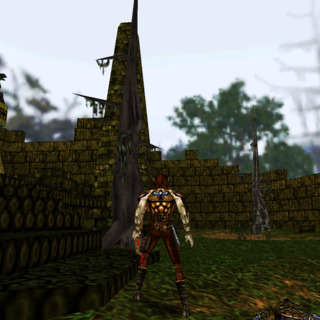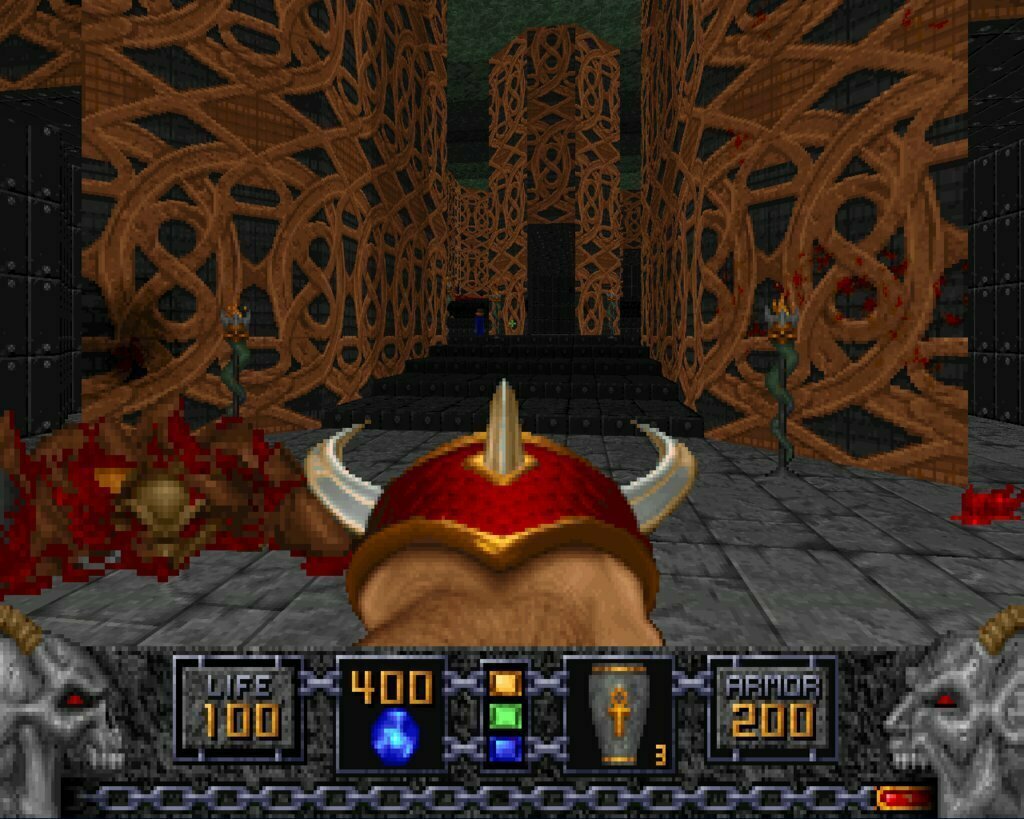

Deathkings contains three additional hubs set in the Realm of the Dead, in which the player must fight through and find their way home. We would only need to wait until 1996 to find out when Hexen: Deathkings of the Dark Citadel was released. Once defeated we receive the chaos sphere and we are warned there are other players mightier who are still plotting their next move. The game is around 10 hours to complete and ends in a final battle with Korax he attacks with six projectiles at a time and the ability to teleport. They are notable as Hexen could play tracks in Redbook audio format from the CD itself, improving the overall quality of the recordings, whereas Heretic and Doom used MIDI tracks. The music, done by Kevin Schilder, are standard dark, atmospheric tunes which work for the environment but do not stand out as anything memorable. The stained glass adds some really beautiful color to the opening levels and can all be satisfyingly smashed. Doors creaking, swirling leaves, ambient hoots and screams all combine to make the world feel that much more alive. With both the visuals and audio Hexen embraces the dark fantasy setting and produces one of the finest looking and sounding games on the Doom engine.
#HERETIC GAME HOODS HOW TO#
In practice it can lead to some frustration and confusion as to how to complete hub areas, which key items have been found and where and on occasion a player can find themselves stuck not sure as to where to go next. The opportunity to move between levels through a central hub makes the world’s feel more interconnected and as a part of a whole. Find the key item in each level and it will open up the next hub, and so on. Activate a switch in one level and it will unlock access in another. Players can go in and out of levels in each hub as if they are one giant area. There are five hubs in the game, each with an average of five maps, one which was hidden. Hexen introduces hubs, each linking to a number of levels that must be explored. The core level loops here innovate for better and worse on the typical Doom engine model by shifting from key finding within a contained level leading to an exit. Ultimately, however, the way a character causes damage in combat feels different for each class, the way those classes respond to the levels and puzzles doesn’t change and it makes the replayability of each character class only appealing to the most dedicated. The three character classes have unique strength, armor and magic ratings which change the way they interact in combat and for a game from 1994 at the height of the 2.5D FPS genre, this is pretty damn cool on the surface. The difference in each character can be felt in the way you play and the way Mana is used is a very inventive iteration on the FPS formula at the time. The first weapon for each character uses no mana, the second blue, the third green and the ultimate weapon for each character expends both at the same time.


Ammo in Hexen is measured in green and blue mana pickups and each class of character has four unique weapons. Upon starting the game, players are given the choice between three character classes. It mixes those RPG-esque elements with the rapid pace and brutality of the FPS genre and creates something fairly unique for the time. By no means a role playing game, Hexen does provide choice, or at least, the illusion of choice, through its hub level design, inventory system and its character select. Hexen sometimes feels like wants to be a Doom and Dungeons and Dragons (D&D&D?) campaign, and in some ways it succeeds. Whereas Heretic often felt like a coat of Dark Fantasy Paint™ over a Doom game, Hexen feels like a more realized vision of the original concept. Hexen’s buildings have as much character as the creatures roaming them and are vital to setting the atmosphere. A giant bell at the top of a tower rings to reveal a teleporter. Switches shift entire sections of walls in ways that feel like the coolest Dungeons and Dragons traps. The first door in the game doesn’t just open, it creeks. This is the best the Doom engine has ever looked as it is used to create atmospheric storytelling to sell the Dark Fantasy setting.
#HERETIC GAME HOODS MANUAL#
Hexen shifts our focus Beyond Heretic (cough) to Cronos, a human world where the second Serpent Rider, Korax has control of something called the Chaos Sphere and is described in the manual as having a “lust for power only matched by his hatred for all living things not under his control”. Heretic chronicles the destruction of D’Sparil, the first of the Serpent Riders, at the hands of an elven hero named Corvus. Hexen: Beyond Heretic took one step forward and two steps sideways in the evolution of the dark fantasy FPS Nineteen months after the release of Heretic, another evolution in the FPS genre and Doom’s 2.5D engine was released continuing the Serpent Rider trilogy.


 0 kommentar(er)
0 kommentar(er)
